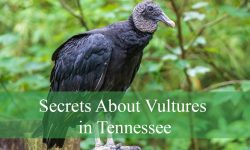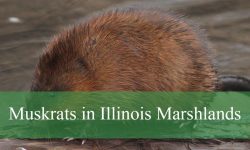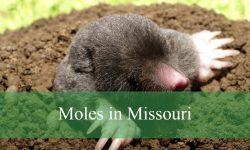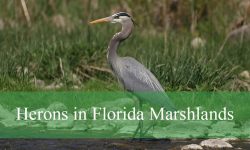In gardens and landscapes, black and orange bugs are frequently observed, displaying a variety of sizes and shapes. These vibrant colors are exhibited by beneficial insects like ladybugs and beetles, however some insects can also be nuisance pests that can bite, harm plants, or release an unpleasant stench when crushed. These colorful beetles occasionally break into homes.
This article provides pictures and thorough explanations to help identify black and orange bugs, which include beetles, weevils, stink bugs, and other insects.
Different types of Black and Orange Bugs
Mountain Laurel Scarlet Mirid

A common bug in Texas, the Mountain Laurel Scarlet Mirid (Lopidea major) is an orange and black insect that feeds on plants. These long, elongated bugs, which can grow up to 9 mm in length, feed on a variety of green leaves but don’t do much harm because of how slowly they reproduce. Mountain Laurel Scarlet Mirids, which are native to a variety of warm settings, are frequently spotted in parks in Texas. They add to the diversity of insects in the area without causing significant harm to the plant life.
White-Crossed Seed Bug
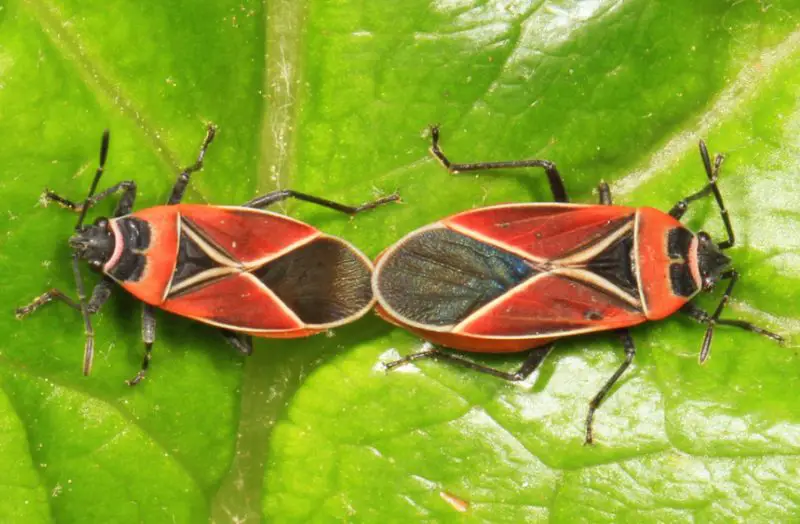
Neacoryphus bicrucis, also known as the white-Crossed Seed Bug, is easily recognized by its striking orange-red hue, which is complemented by small black portions and characteristic white bands in the shape of an X that divide the orange and black sections. Although they don’t have a big impact on the groundsel environment, these bugs are very prevalent on these plants. They have the ability to infiltrate groundsels and contribute to their reproductive cycle by depositing their eggs on the underside of leaves.
Mediterranean Red Bug
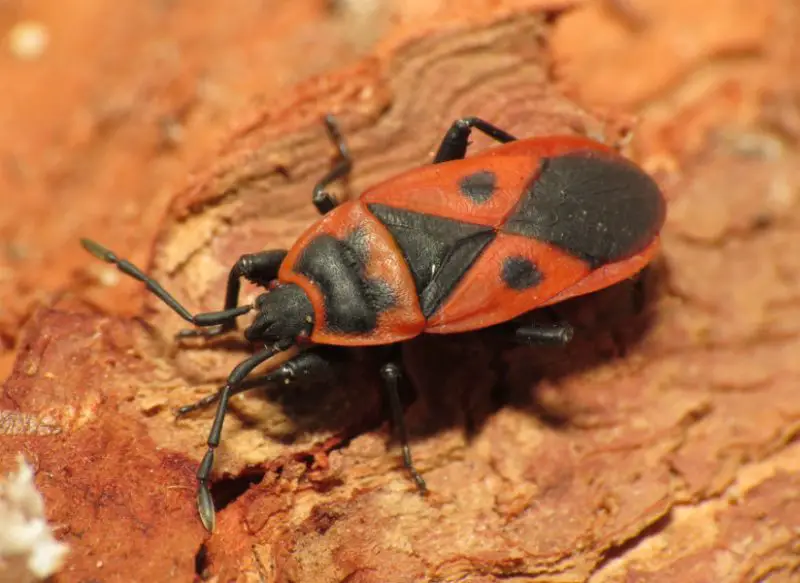
The color pattern of the Mediterranean Red Bug (Scantius aegyptius) is similar to that of White-crossed Seed bugs; it is primarily red or orange in color, with black patches on the dorsal and ventral surfaces. With black antennae, head, and legs, this species is common throughout North America and can grow up to be 10–12 mm in size. The Mediterranean Red Bug is a noticeable species in many parts of the continent due to its unique color and size.
Anchor Stink Bug
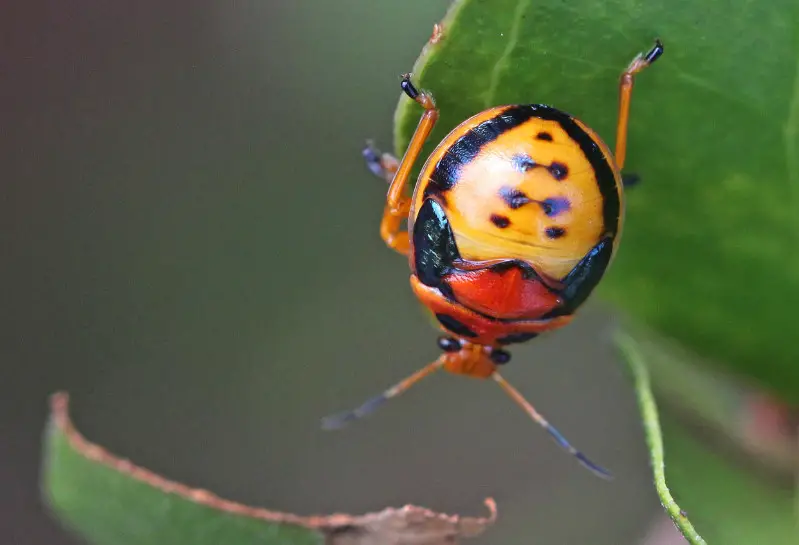
The occurrence of the Anchor Stink Bug (Stiretrus anchorago) on crops, ornamental flowers, cauliflower, and cabbages is well-known. Its form is mostly black, with an orange-red spot on its back abdomen, giving it a black body overall. This carnivorous stink insect, with a spherical, flattened body, feeds on several invasive species in soy and alfalfa fields, including the Mexican Bean Beetle. The Anchor Stink Bug is not limited to a particular season and is still active in its typical areas, which include Southern Florida.
Metriorrhynchomiris Dislocate
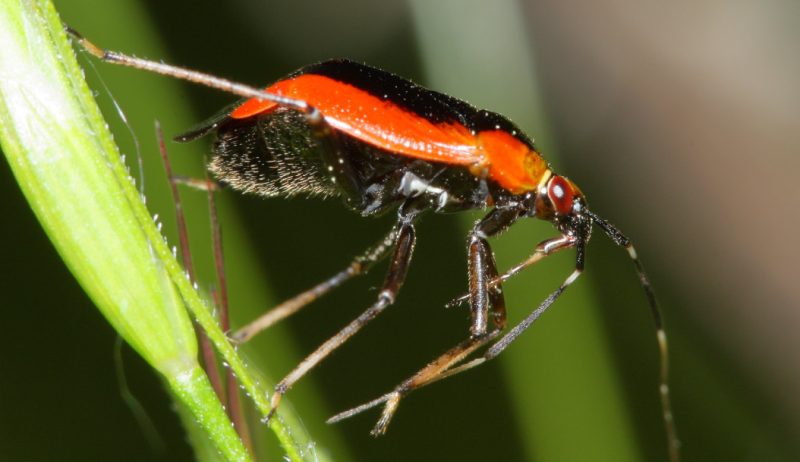
A species of plant insect that is common throughout North America, the Metriorrhynchomiris Dislocate has a unique orange-black or black-orange coloring. Often seen in flower and agriculture areas, the ladies are primarily orange in hue, with the males being more toward black. This genus, which is well-known for having orange stripes bordering its black body, also exhibits color inversions, with black stripes on an orange body. The visual variety of this species is further enhanced by variants that are almost entirely black with a collar behind the head that is predominantly orange.
Common Cotton Stainer Bug
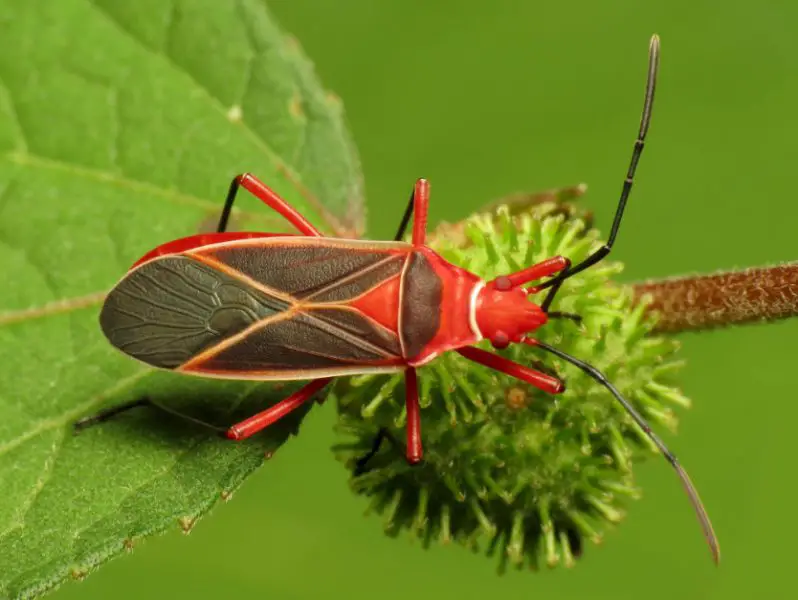
Dysdercus suturellus, commonly known as the Common Cotton Stainer Bug, is a common insect found in Georgia and Alabama. It is easily identified by its distinct black dorsal and orange-red ventral sides. This genus of bugs can be easily identified by their vivid orange-red heads and unique X-shaped dorsal mark. Every morph shares the same white mark. Known for its propensity to discolor cotton, this species is a major pest in citrus farms, especially oranges, where it melds with the fruit’s color and does considerable harm.
European Firebug

While it doesn’t eat squash, the European Firebug (Pyrrhocoris apterus), a common black-orange species in Europe and Asia, is occasionally mistaken for the Common Squash bug. Rather, it feeds on the seeds of lemon trees, which is why it is prevalent in areas with lemon trees throughout Southern Europe and Asia. These bugs can be imported with lemons or lemon plants. They are easily recognized by their red and black or orange and black dorsal, which is frequently decorated with irregular stripes. The diurnal European Firebug is a sun-loving species that is most commonly seen on the sunny side of trees.
Charcoal Seed Bug

Because of the mild environment, the Charcoal Seed Bug (Melacoryphus lateralis), which is native to North America, appears all year long in arid desert habitats. They have little colored dots behind the head and a dark charcoal tint that almost looks black with red or orange edges. These bugs are sociable by nature and live in close quarters with one another, using social living as a tactic to improve defense against predators, particularly birds. Even though they don’t create nests, they stay close to one another and encourage a social lifestyle.
Eastern Bloodsucking Conenose
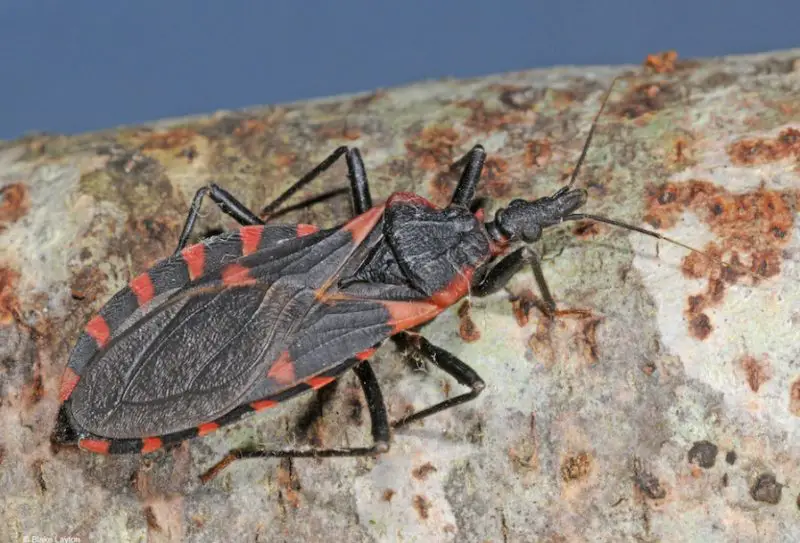
Because of their vicious nature, the Eastern Bloodsucking Conenose bugs (Triatoma sanguisuga) provide serious risks to public health. Juveniles eat in between molts, and females need blood meals to lay eggs. These bugs are nocturnal and active both indoors and outdoors. They might be difficult to find since they hide in quiet places or beneath furniture. They prefer to hide under leaves and fallen branches in their natural habitat. These insects bite people and other animals, such as raccoons and rats, which are frequently discovered in their nests. The bites of the Eastern Bloodsucking Conenose bug can be harmful, which highlights the necessity of controlling their prevalence for public health purposes.
Red Bull Assassin Bug
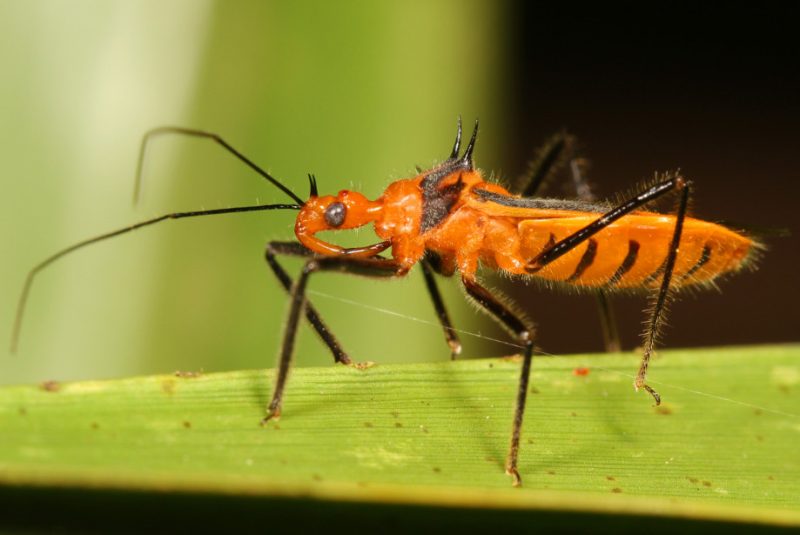
As a predatory species, the Red Bull Assassin Bug (Repipta taurus), which may grow up to 11 or 13 mm in length, uses ambush tactics. It is distinguished by its brightly colored body, which has black legs, and orange pigmentation on both the dorsal and ventral sides. The ventral side has black stripes and is primarily orange in color. The insect is notable for having an orange head with small black eyes and a black dominating dorsal with orange stripes around the borders. It is frequently observed on orange flower buds, where it displays its skillful hunting habit by patiently waiting for its next meal.
Bee Assassin
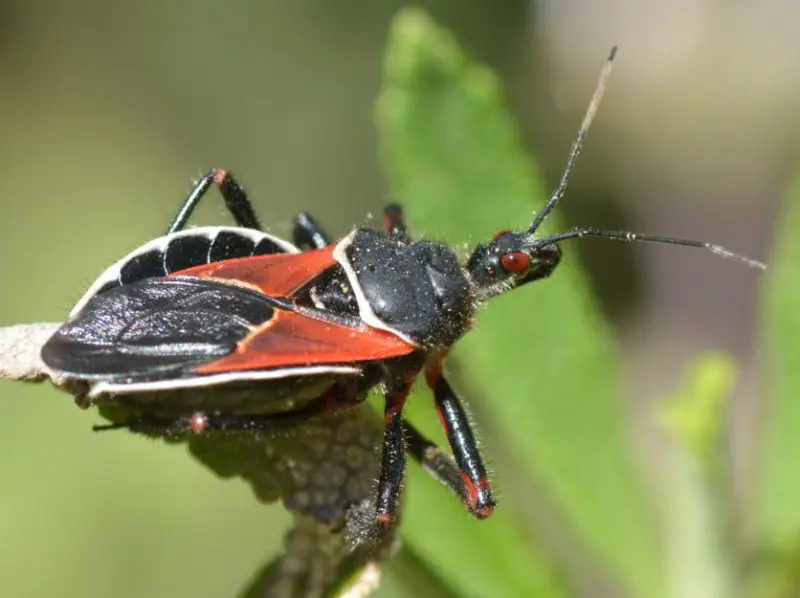
Acting as both a helpful and a harmful species, the Bee Assassin (Apiomerus crassipes) plays a dual role in the environment. Despite the fact that its bee-eating practices may be harmful to natural pollinators, it preys on a variety of bees, some of which might not be effective pollinators. By feeding on ants, even flying ants, the Bee Assassin, on the other hand, benefits society. These black-colored insects with orange edges show off their hunting skills by placing themselves on flower buds that bees frequently visit. To further emphasize their varied ecological influence, they walk on flowers and interact with ants, beetles, and butterflies that are involved in the production of honeydew.
Meadow Plant Bug
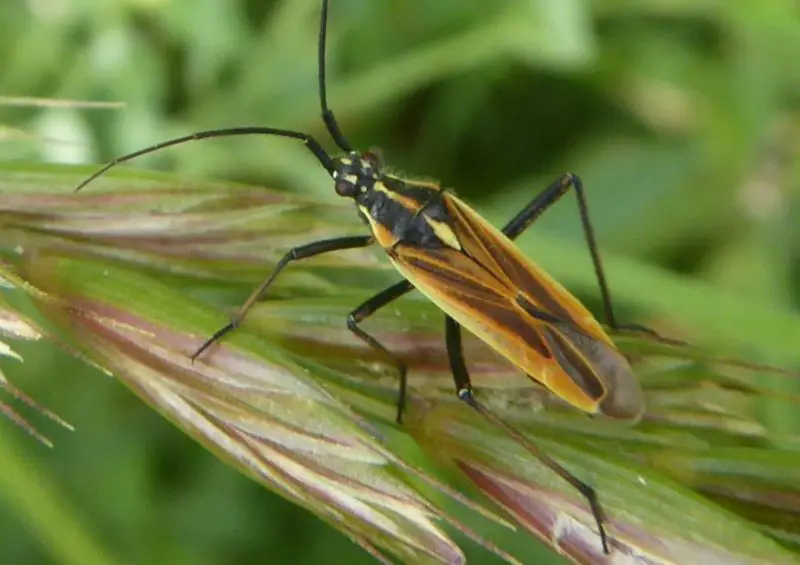
According to its name, the Meadow Plant Bug (Leptopterna dolabrata) is a common black and orange-brown bug species that is found in grassy fields, meadows, and prairies. It originated in Europe and was brought to North America, where it had a noticeable detrimental effect on grass. The fact that this beetle is so common indicates how adaptable it is to different habitats and circumstances.
Large Milkweed Bug

With a maximum size of 12 mm, the Large Milkweed Bug (Oncopeltus fasciatus) is found throughout North America, South America, and the Caribbean. It is easily identified by its characteristic black and orange appearance, which includes an orange X-shaped pattern on its dorsal side and a black lower belly. Interestingly, it is the only orange-and-black species with a noticeable black bar running across the dorsum’s X-shaped markings. As its name suggests, this beetle mostly eats the seeds of Common milkweed, but it also likes Caribbean milkweed and nerium flower seeds.
Eastern Boxelder Bug
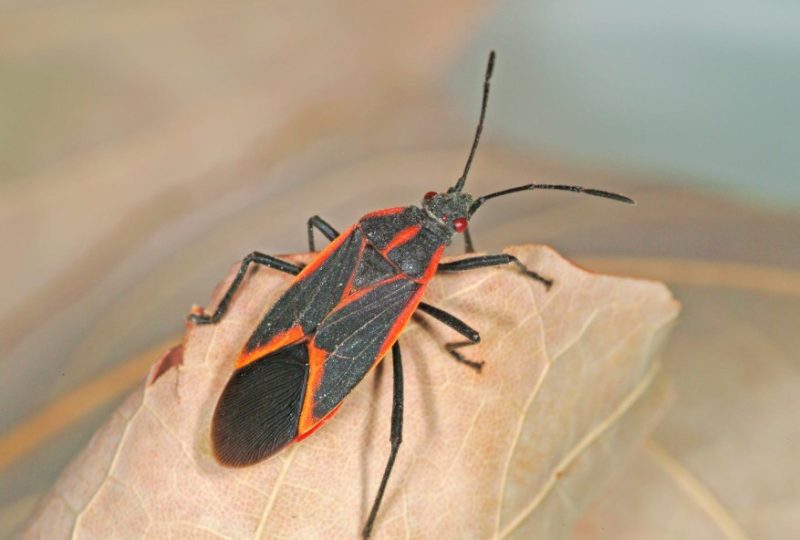
Native to the United States, the Eastern Boxelder Bug (Boisea trivittata) is distinguished by its dark brown, almost black body and a characteristic red line running along its sides. These bugs, which can grow to a maximum size of 12.5 mm, are common throughout the summer and spend the winter inside of structures. They live in mixed woodlands and occasionally meadows outside of boxelder, maple, and ash trees.
Small Milkweed Bug
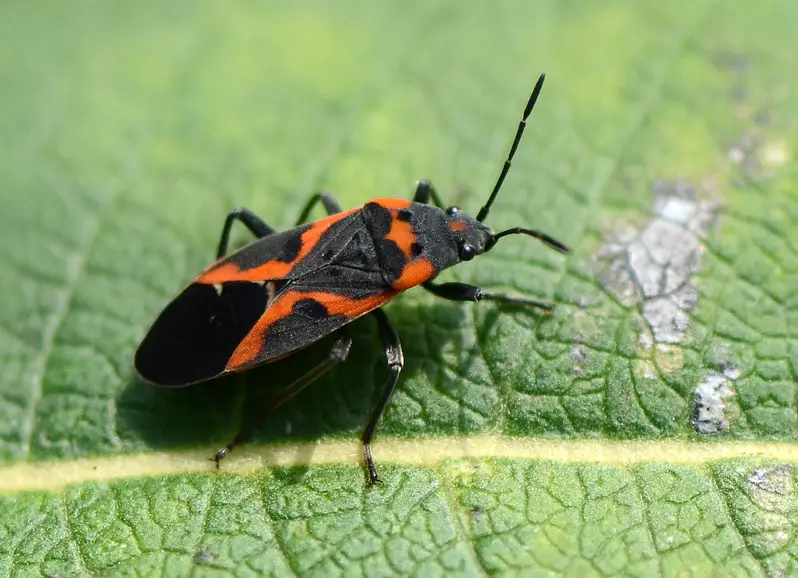
The oval-shaped body of the Small Milkweed Bug (Lygaeus kalmii) is primarily black with noticeable orange-red diagonal lines. Although it originated in the US, it is now found around the world. Fittingly called, these insects lay their eggs on milkweed and survive by feeding on its nectar. If milkweed isn’t available, they could turn to eating flies and other insects despite looking like little cockroaches.
Two-Lined Spittlebug
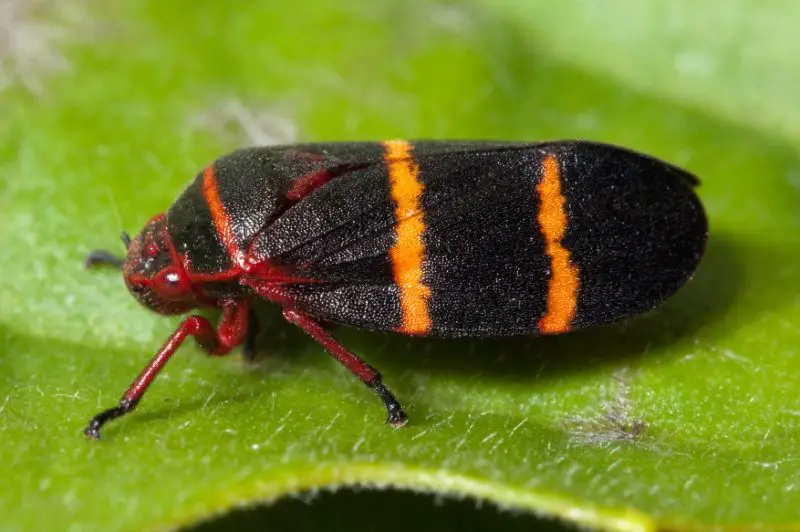
Prosapia bicincta, often known as the Two-Lined Spittlebug, is a little pest with an almost black body and two yellow horizontal lines on its elytra that can grow up to an inch in length. They can harm grass, flowers, and plants, but they pose little threat to gardens. Particularly young Two-Lined Spittlebugs might cause more damage since they grow to adulthood by feeding only on certain plants. These insects frequently live in ornamental plants, and they are sometimes seen momentarily eating weeds.
Harlequin Bug
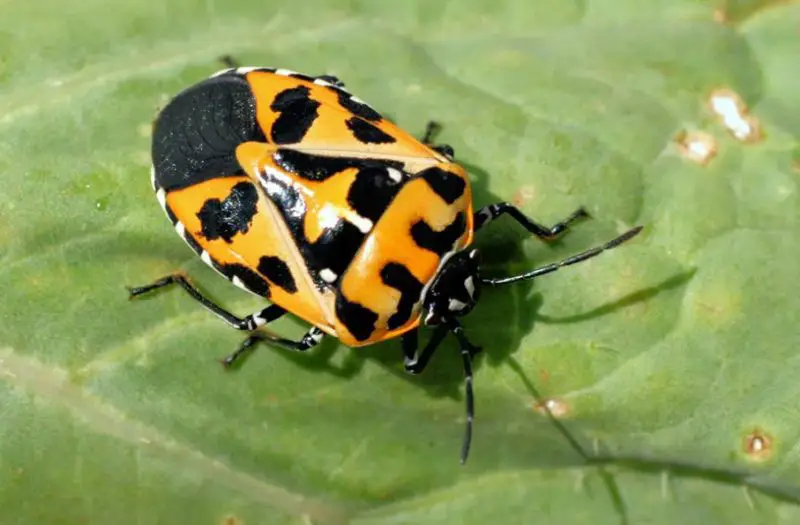
At 9.5 mm in length, Harlequin Bugs (Murgantia histrionica) are distinguished by their fondness for cabbages. They overwinter as dormant insects, emerging in the early spring to feed on crucifers such as cauliflower and cabbage. They have a black body with orange or red markings on it, as well as black legs and antennae. Until the cabbage is no longer viable, these beetles extract sap. When their population is controlled, management techniques like hand-picking or pesticides may be used.
Milkweed Assassin Bug
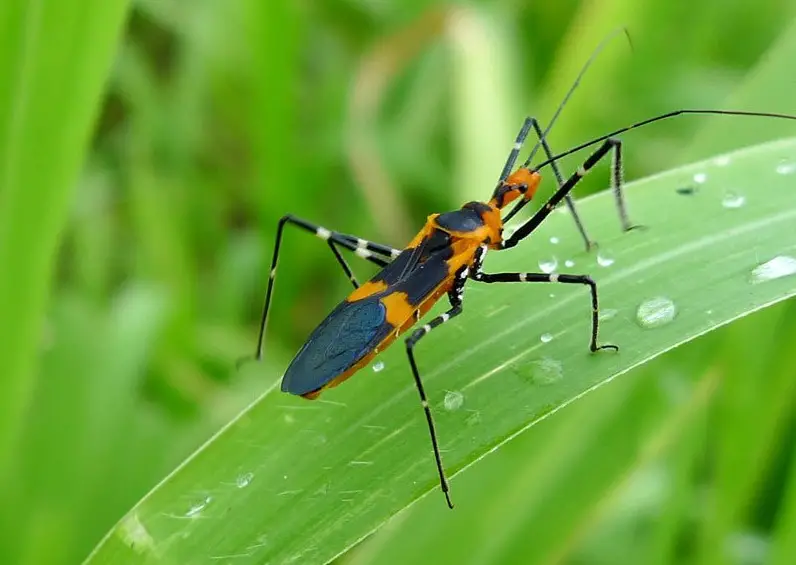
The Milkweed Assassin Bug (Zelus longipes), which is native to North America, has an oval-shaped body that is flattened and extends to a length of 18.5 mm. They are well-known predators with a varied diet that may be advantageous in gardens. It’s important to remember that these bugs can bite, leaving a painful aftereffect. They use ambush methods to catch soft-bodied prey, such as beetles, flies, mosquitoes, and armyworms, among other insects.
False Milkweed Bug
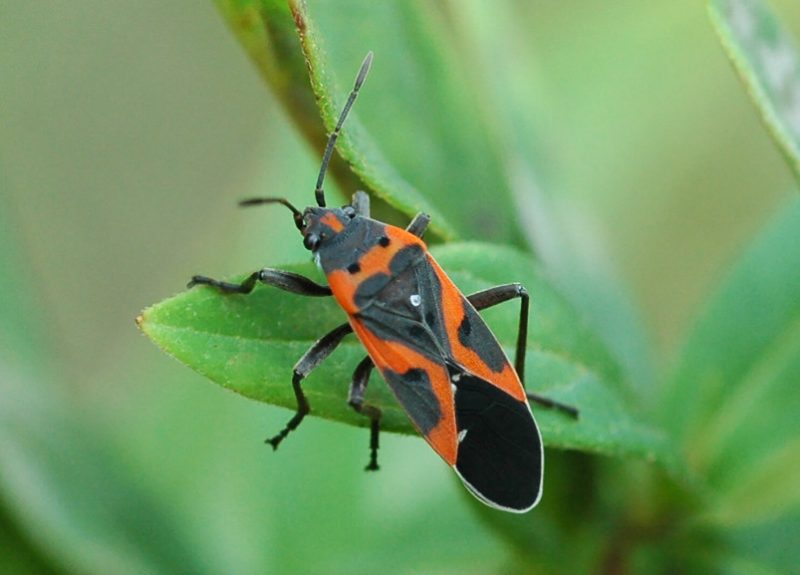
The oval-shaped, flattened body of the False Milkweed Bug (Lygaeus turcicus), which is native to Eastern North America, is striped with red. They resemble sunflowers and are frequently found on counterfeit sunflowers. They have a fondness for the seeds of these flowers. Because many members of the genus have similar orange lines, they are sometimes confused for bugs that are colored both black and orange. Still, their relationship with false sunflowers is a major differentiator that helps separate False Milkweed Bugs from other similar species.
Western Boxelder Bug
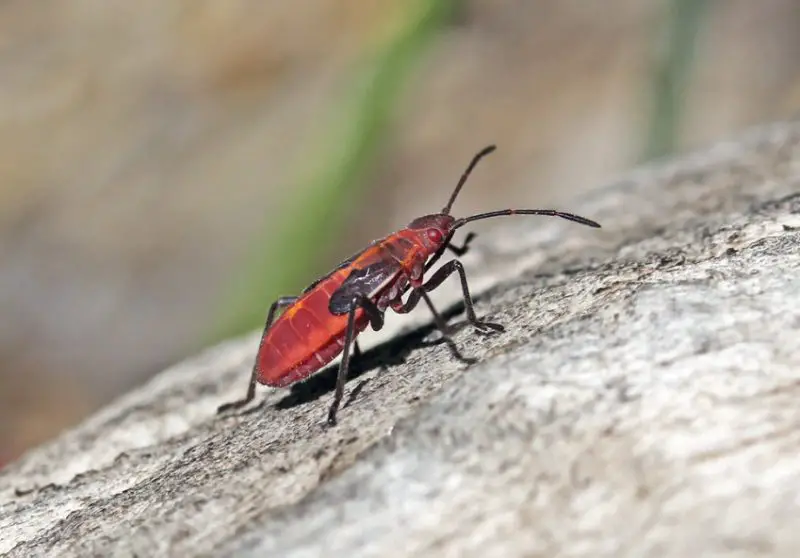
Western Boxelder Bugs (Boisea rubrolineata), which are native to the West Coast, are very common in California, notably in the Los Angeles area. Their bodies are a striking black with orange-red lines, and they are mostly fed by boxelder and maple trees. Their abdomens are also orange-red in color. certain bugs favor fruit, but they also frequently eat the seeds of certain trees. Western Boxelder Bugs are primarily found in warm, dry climates, while they can occasionally enter homes.
California Bordered Plant Bug
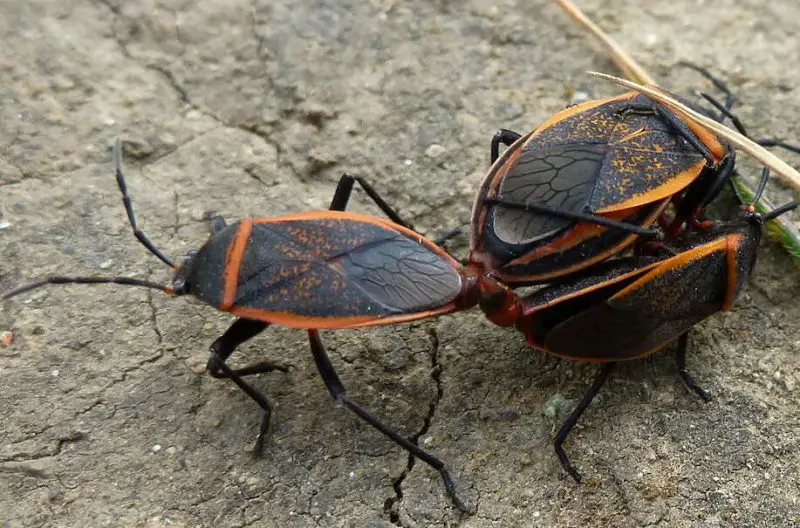
Known by their characteristic orange body stripes, California Bordered Plant Bugs (Largus californicus) are found throughout the Western United States, especially in California. They are black in color and have pointed mouths that they use to get liquids out of flowers and plants. These little larger than one-inch bugs are easily recognized since they retain their distinctive look as adults. They have a wide diet and are well-known for piercing and eating a variety of soft fruits, especially strawberries. California Bordered Plant Bug nymphs have little, black bodies with an orange-red marking on them.
Orange Assassin Bug
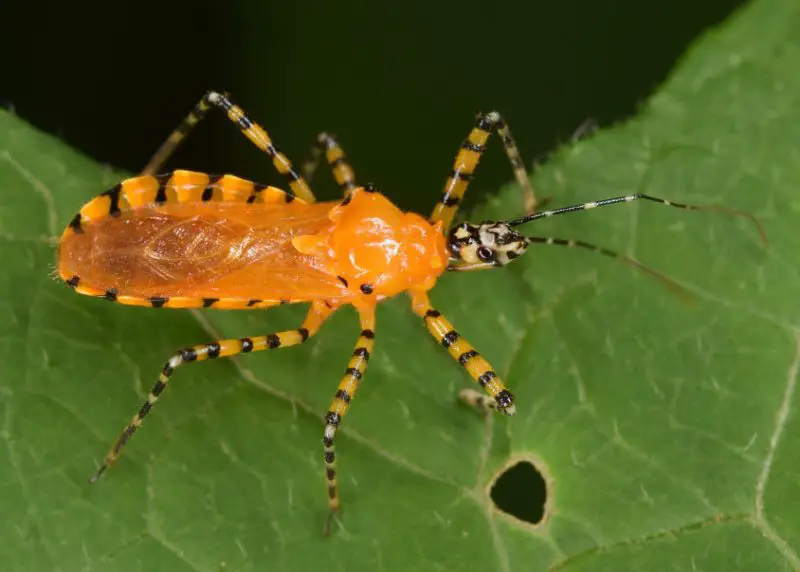
The most common black and orange bug in North America, the orange assassin bug (Pselliopus barberi), has a bright orange color with yellow-golden undertones. It is an assassin bug, meaning it feeds on insects and uses ambush tactics with its legs banded in black and orange. These bugs are nocturnal hunters and like the habitat of woodlands with low lying leaf heaps. They exhibit a flexible and adaptable lifestyle by hiding out for the night under the bark of trees or in the cracks in trunks.
Jagged Ambush Bug

Phymata americana, or jagged ambush bugs, are expert ambush predators who wait patiently on flower buds for unwary insects. These bugs have a genus-specific color adaption that allows them to mimic the hues of their host plants. They have an orange body with black portions. Their ability to blend in increases their likelihood of going unnoticed, which speeds up the process of capturing insects. These crafty assassins frequently prey on bees, luring them in as the bug plots its ambush. The female Jagged Ambush Bug differs significantly from the male in that it is larger and moves more quickly while ambushing.
Eastern Bordered Plant Bug
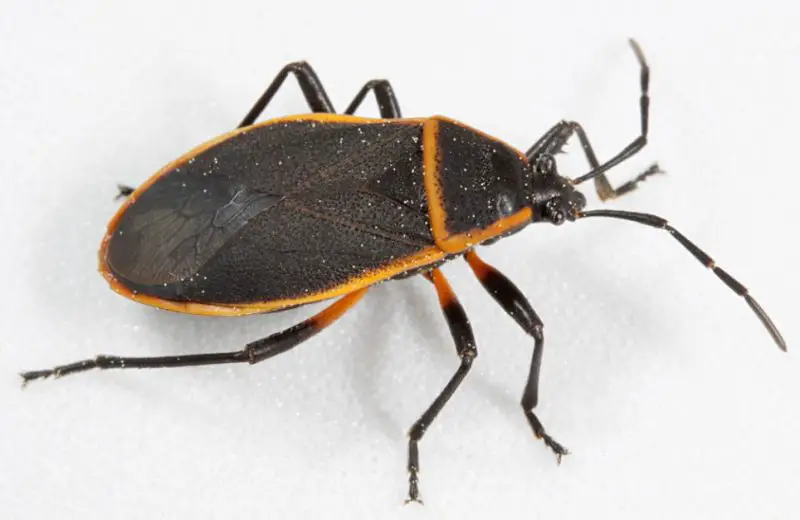
The body of the Eastern Bordered Plant Bug (Largus succinctus) is decorated with tiny black dots all over with orange edges that range from dark brown to black. Both the dorsal and ventral sides display this coloring. The pure orange bands have no hint of yellow or red, in contrast to other Bordered Plant Bugs. These insects mate and deposit their eggs on plant leaves. They have extended mouthparts for sucking plant sap. When darkness falls, they hide in tree cracks and natural crevices or beneath the bark of trees.
Cactus Coreid
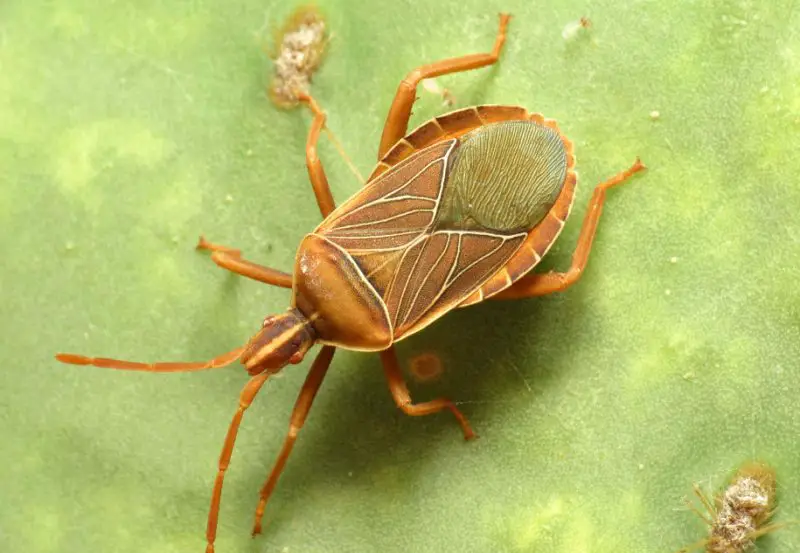
A dark or black body with borders of yellow and orange, and occasionally orange-brown tones, is the characteristic of the Cactus Coreid (Chelinidea vittiger), popularly called cactus bugs. Their body is marked in characteristic orange and yellow stripes, making them easy to identify. Eating only cacti, as its name suggests, the Cactus Coreid leaves clear evidence of its incursion. When feeding scars are severe, the cacti’s once-green color changes to a pale yellow color due to the profusion of these tiny yellow circular dots.
Speckled Sharpshooter
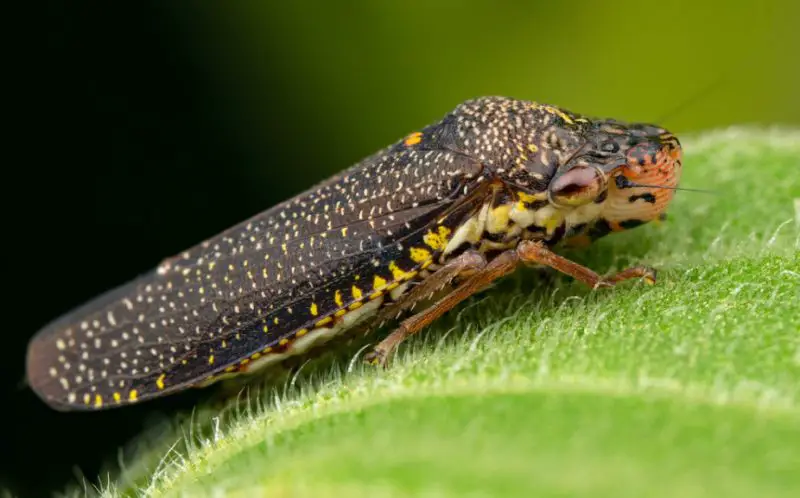
The beetle known as the Speckled Sharpshooter (Paraulacizes irrorata) is distinguished by its black body that gives the impression of being painted with orange paint. In addition to having a black head and legs, its elongated body has an orange-yellow underside. These bugs, which have a characteristic shine and measure an average of 12 mm in length, are always interested in feeding or laying eggs. They have a distinctive appearance and a dual concentration on reproduction and nourishment as they lay their eggs in twigs or stems.
Conchuela Bug
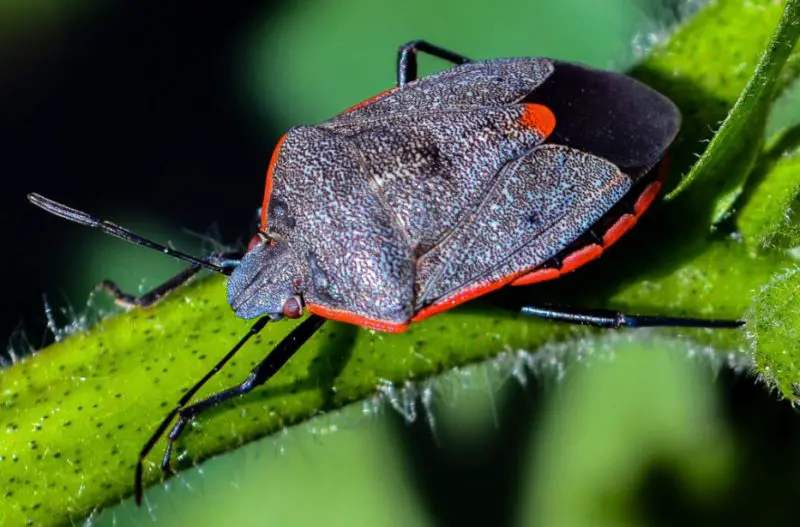
After overwintering as adults, conchuela bugs (Chlorochroa ligata) emerge in the spring, frequently behind leaf litter, rocks, or logs. They have a brown body with black dots and bright orange striping, and when spring arrives, they go in search of food. The bright orange band veers more toward red than yellow. They might be green or black in hue. These hardy bugs have a lifetime that includes up to thirty days for the eggs laid by the females after mating.
Florida Predatory Stink Bug
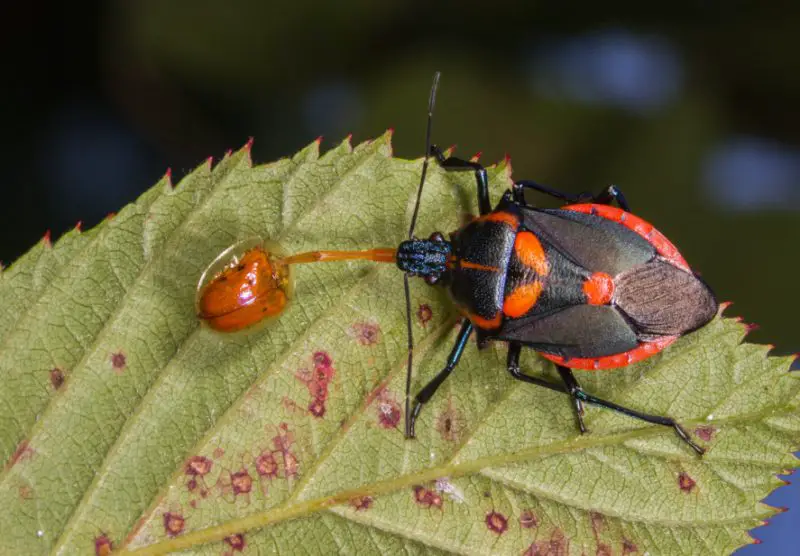
The Euthyrhynchus floridanus, also known as the Florida Predatory Stink Bug, is a black insect with orange or red markings and stripes. Its body is shaped like a shield and narrows toward the back abdomen. It is often seen on flowers, citrus fruits, and decorative plants. Throughout its life cycle, it feeds on a variety of species. While the adults eat a wide variety of foods, including smaller stink bugs, weevils, beetles, and bug larvae like cutworms, the larvae feed on moths. An astounding clutch of up to 140 eggs can be laid by mature females, which helps to sustain the Florida Predatory Stink Bug population.
Ringed Assassin Bug
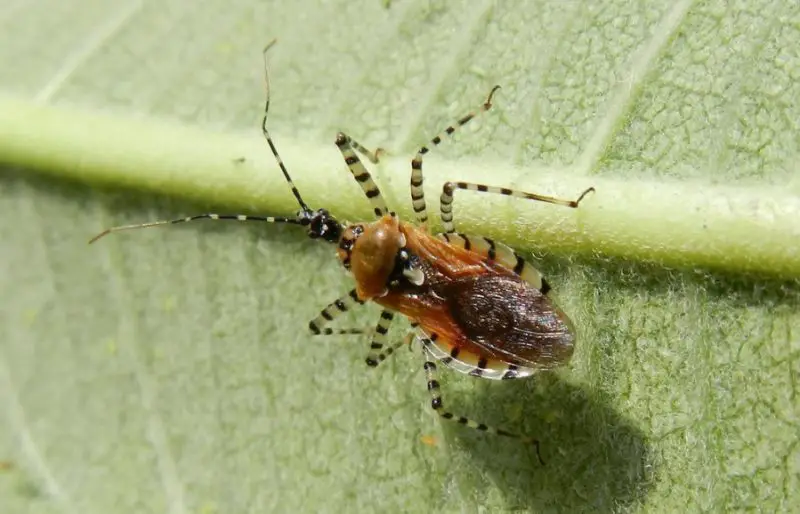
Pselliopus cinctus, sometimes known as the Ringed Assassin Bug, is a predatory bug that eats small insects, bugs, and larvae. Their unique orange-black coloring includes an oval body with brown tones that are highlighted by yellow borders. Their head is mostly black, and their legs are decorated with black bands. In spite of their carnivorous nature, Ringed Assassin Bugs exhibit adaptability by partaking in nectar from flowers, indicating a diverse diet as part of their predatory habits.
Bagrada Bug
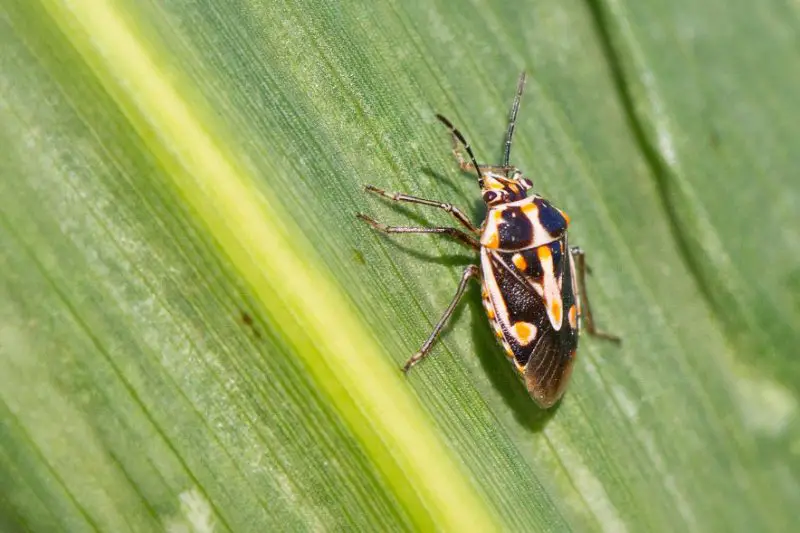
Bagrada bugs (Bagrada hilaris) are similar in size and shape to stink bugs at first, however they may be distinguished from one another by their longer bodies. Growers and farmers in California face difficulties with these orange and black pests. They are easily recognized by their orange-spotted black body with white borders and a central orange line with white borders. They are pests of cruciferous vegetable crops, such as cauliflower, kale, and cabbage. Vegetables become weeds when they are scarce. Bagrada bugs are acknowledged as major pests not just in California but throughout the entire Southwestern United States region.
Redcoat Seed Bug
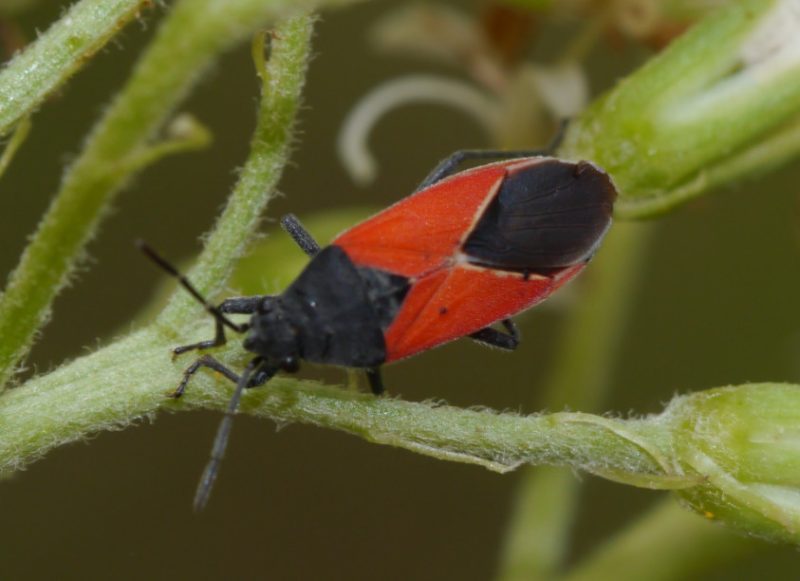
Melanopleurus belfragei, often known as the Redcoat Seed bug, is a common species in North America that has been divided into up to nine subspecies. It stands out foraging on flower buds and seeds due to its unusual orange color and contrasting black spots. The dorsal surface of the bug has two orange patches on either side of the center line, and two black patches of the same size on the upper cephalothorax and abdomen. This beetle, which is well-known for its vibrant coloring, uses its eye-catching appearance to ward off would-be predators. Its protective properties are further enhanced by the fact that it releases an offensive odor when handled or threatened.
St. Andrew’s Cotton Stainer
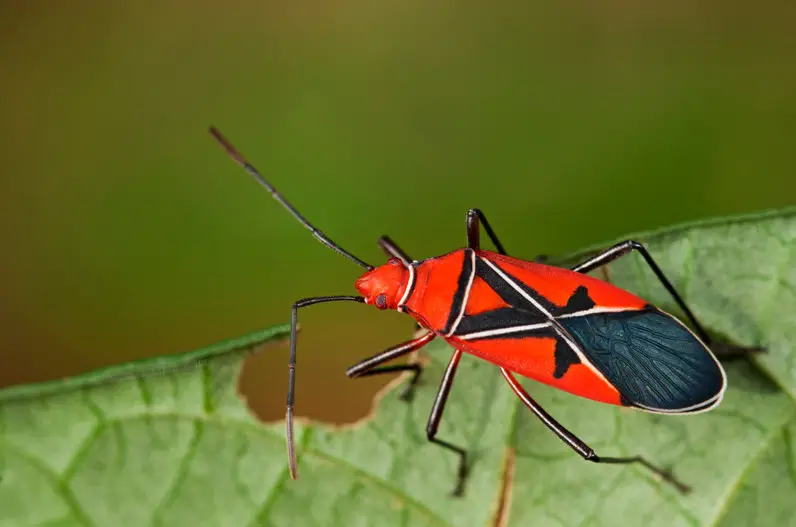
Native to North America and the Caribbean, the St. Andrew’s Cotton Stainer (Dysdercus andreae) gets its name from the Scottish flag of St. Andrew. The beetle is disliked by the locals for staining fruit during feeding, even if it has a unique color pattern. This bug affects cotton development in particular by leaving a colored residue on fruits. The bug’s lower abdomen is black, and it may be identified by its bright orange-red dorsum and a black X-shaped mark with white borders. It is regarded as a serious pest because it is known to eat a wide range of plants and vegetables, particularly in regions with a high concentration of fruit trees. For small orchard incursions, hand eradication might be sufficient; however, insecticides would be needed for larger crops.
Giant Milkweed Bug
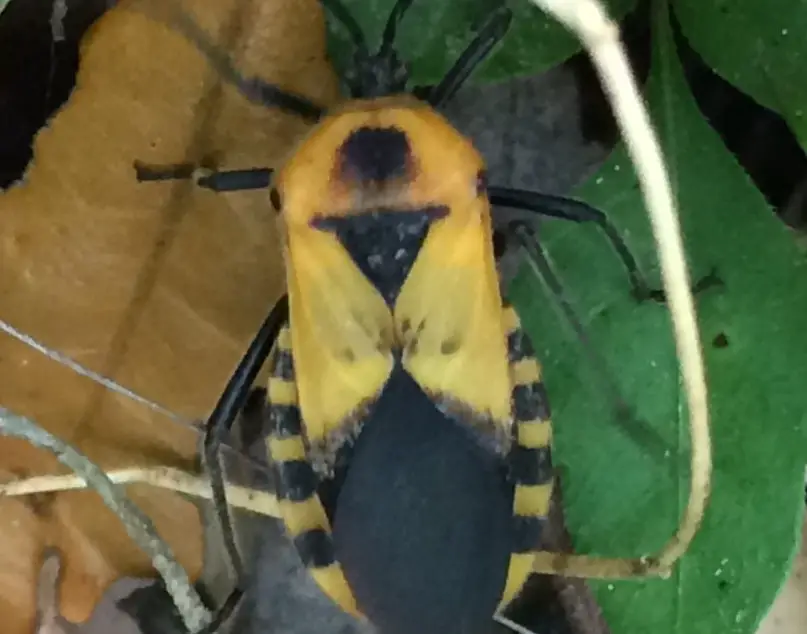
The distribution of St. Andrew’s Cotton Stainer bugs and the Giant Milkweed Bug (Sephina gundlachii), both of which are found in North America and the Caribbean, is comparable. This genus is well known for its tendency to sap plants, especially milkweed plants. This beetle, which is common in regions like Florida, is easily identified by its orange dorsum with orange edges. The insect has tiny black dots on the sides and black markings on its lower abdomen and dorsum. Predators are frequently misled into believing that a species because of its speckled coloring is toxic.
Corsair Assassin Bug
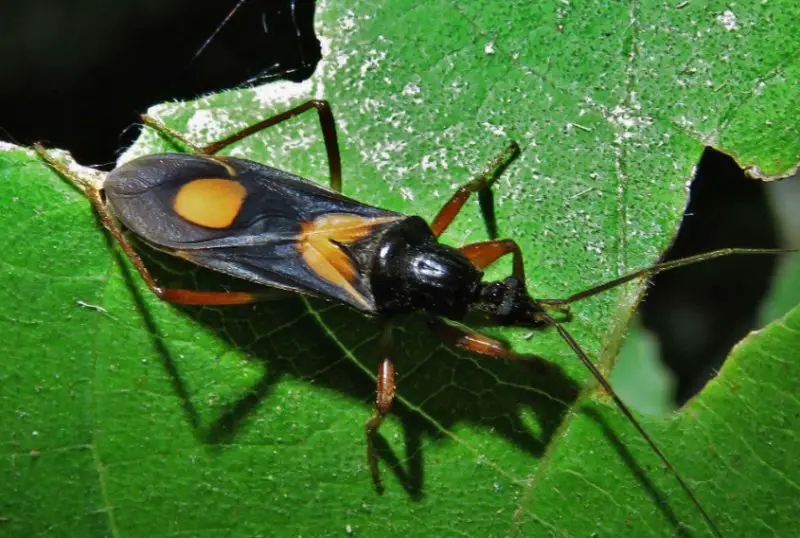
Rasahus hamatus, also known as the Corsair Assassin Bug, is identified by its mostly black body with brown or orange legs and markings on its back. The dorsal side is notably marked with two colorful spots: a circular spot on the abdomen and a chevron-shaped mark on the thorax. These tiny, 7–10 mm, orange-legged predators hide among plants and flowers where they feed on tiny insects and larvae. Corsair Assassin Bugs may be found all throughout the Americas and the Caribbean, demonstrating how common these areas are.
Scarlet-Bordered Assassin Bug
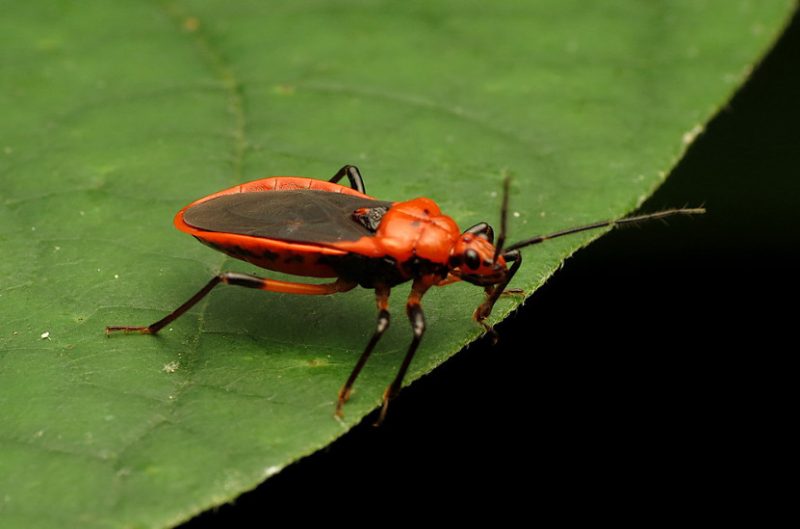
Rhiginia cruciata, often known as the Scarlet-Bordered Assassin Bug, has a stunning orange-red border around its head and legs that contrasts with its mostly black body. Being a nocturnal animal, it spends the day hidden under leaves, logs, or rocks. It is up to 16 mm in size, with an oval-shaped body that is wider at the abdomen and thinner at the thorax and head. It feeds on beetles, insects, and caterpillars. This genus of bugs is characterized by its tan underside and unique appearance. They forage at night and move among plants or the ground in search of food.
Mexican Bordered Plant Bug

A colorful band of orange, red, rusty, or brown surrounds the body of the Mexican Bordered Plant Bug (Largus maculatus), a member of the bordered bug family. These diverse insects are frequently described as having a tan to brown dorsal with bands and markings in black and orange. Their legs are black, and they eat mostly green plants. The Mexican Bordered Plant Bug, which is present all year round in Southern US regions, contributes a vibrant appearance to the region’s varied insect population.
Decula 17-Year Cicada
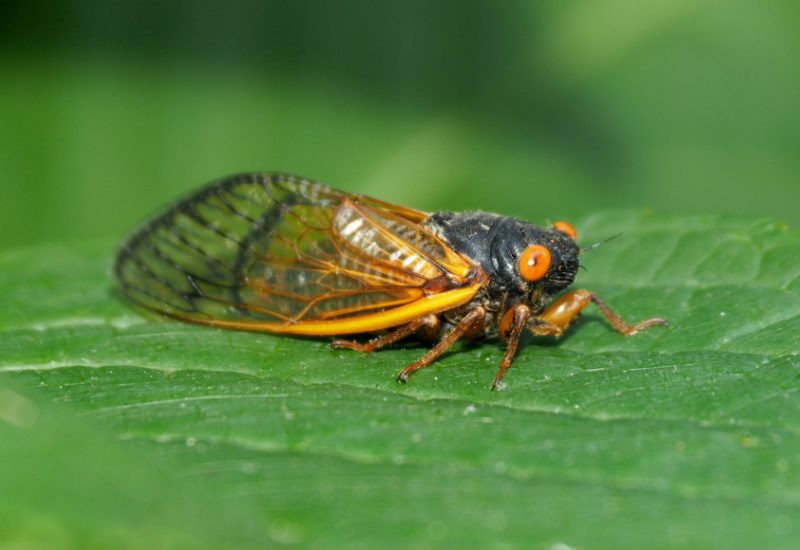
The amazing 17-year lifespan of the Decula 17-Year Cicada (Magicicada septendecula) gives rise to its name. Its orange-colored wings are transparent and noticeably longer than its body, giving it a unique appearance. The beetle has an unusual black and orange color scheme, with orange eyes and a black head and abdomen. These cicadas, which are long-lived and have distinctive characteristics in the natural world, contribute to the complex ecosystems they live in by flying and feeding on a variety of plants and leaves.
Two-Spotted Stink Bug
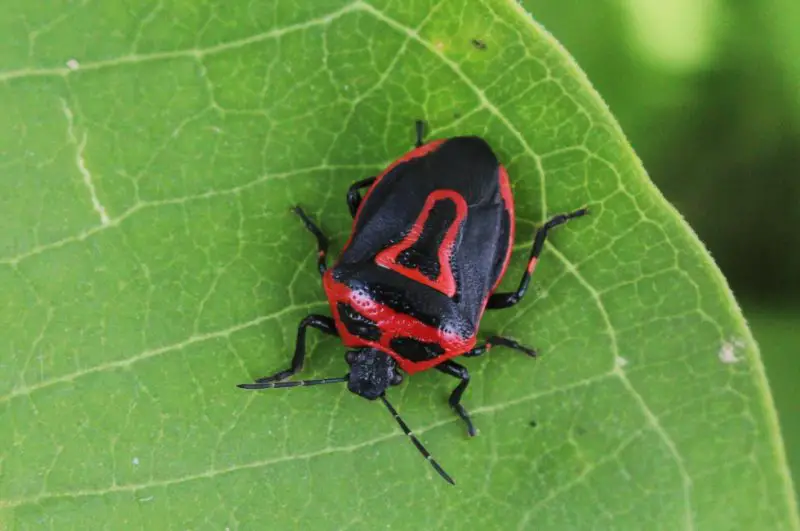
Known for its unique dorsal hues, the Two-Spotted Stink Bug (Perillus bioculatus) is a native species of North America. It is easily distinguished by its distinctive keyhole form on its back and two black spots behind its head, which contrast with its basic black hue, which is embellished with typical red lines and shapes. Being a stink insect, it has an unpleasant appearance that keeps prospective predators away. This species, which is well-known for eating a variety of tiny pest insects, has the potential to be an advantageous addition to crop fields and gardens, aiding in natural pest control.
Eastern Regal Oak Mirid
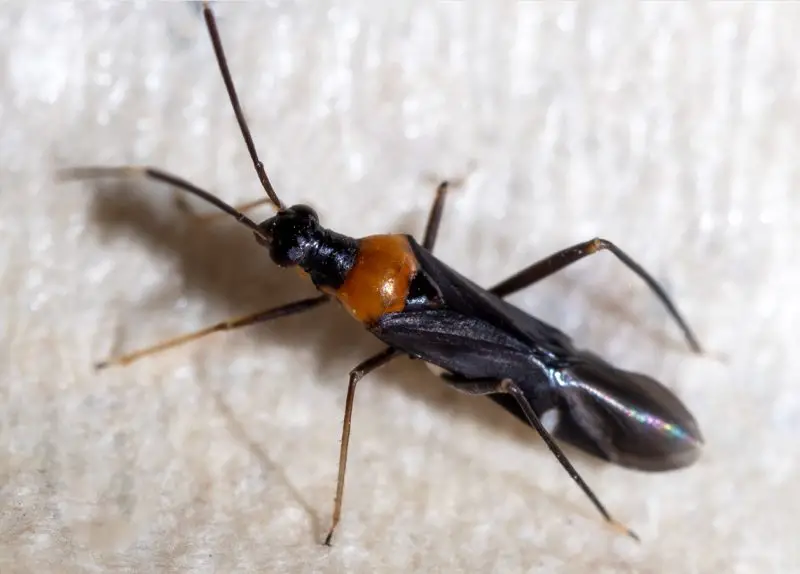
The Eastern Regal Oak Mirid (Pseudoxenetus regalis) is a prevalent species along the Eastern Coast of the United States. It is distinguished by having a long, stick-like body and a striking reddish-orange and black coloring scheme. The legs likewise display the contrasting colors of orange and black, with the orange portion of the head and the remaining black portion. They have an extended body structure and a feeding habit that is similar to that of mirid bugs. These insects, which live in oak woods, contribute to the biodiversity of their woodland habitat by being seen on the ground and among the leaves.
Hedgenettle Stink Bug
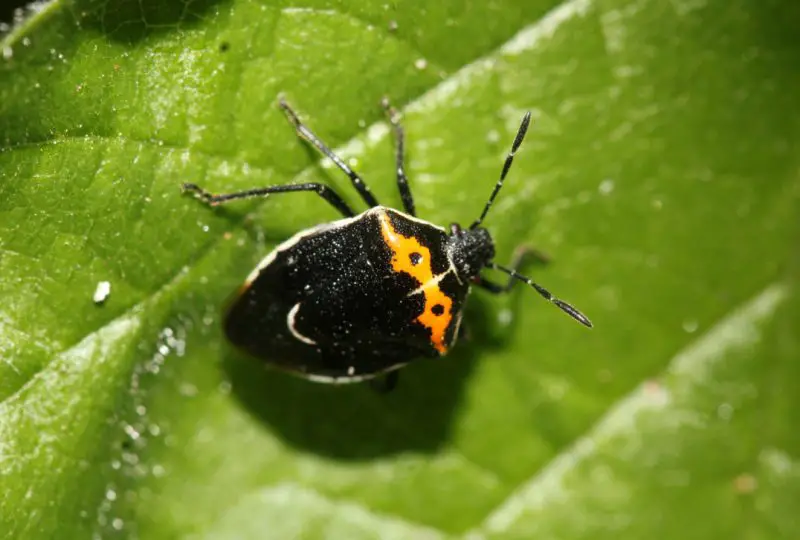
The Happy Bespeckled Stink Bug, or Hedgenettle Stink Bug (Cosmopepla conspicillaris), gets its name from its fondness for the plant it is named after. It has a black body with unique orange patterns that seem like a happy face. This species is distinguished from others by a single orange marking in the shape of a chevron on its abdomen and an orange mark behind its head that has two black dots that resemble speckles. Its remarkable look in its natural habitat is partly attributed to this unique hue.
The contours of its body are highlighted by thin orange lines. These bugs, which belong to the Stachis genus, are distinguished from other dark-colored stink bugs with speckle-like characteristics. These patterns have a particular touch because of their characteristic orange tone. Usually up to an inch in size, these bugs have a shield-like form that is indicative of their inedible nature.
Six-Spotted Milkweed Bug
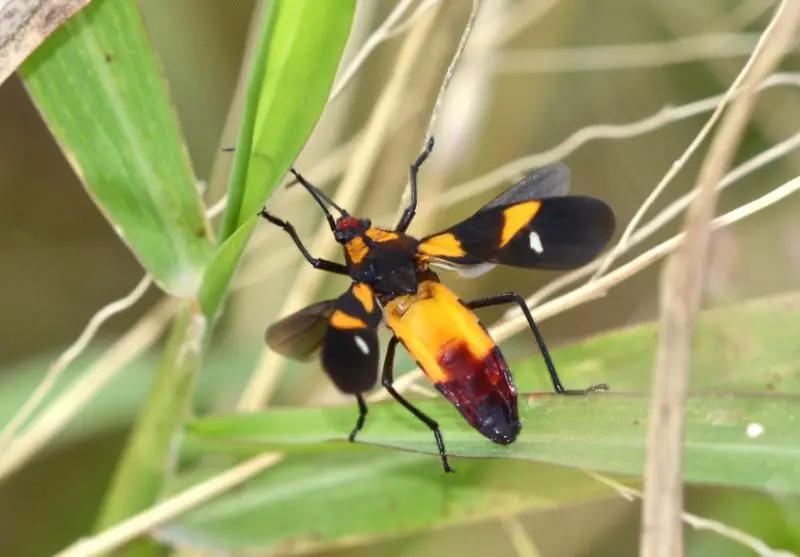
The Six-Spotted Milkweed Bug (Oncopeltus sexmaculatus), so named because of the six orange spots on its dorsum, is one of the longest black and orange insects in North America. They are often seen near vivid blooms because of the striking hues of their bodies within this species. In particular, orange-spotted Six-Spotted Milkweed bugs prefer flowers with orange tones, such as Butterfly weed. It is noteworthy that six different color morphs, including red and yellow, have one unique characteristic in common: a black dorsum with bright dots. The beetle has a vivid red mark on its head, but its legs and antennae are completely black.
Western Corsair Bug
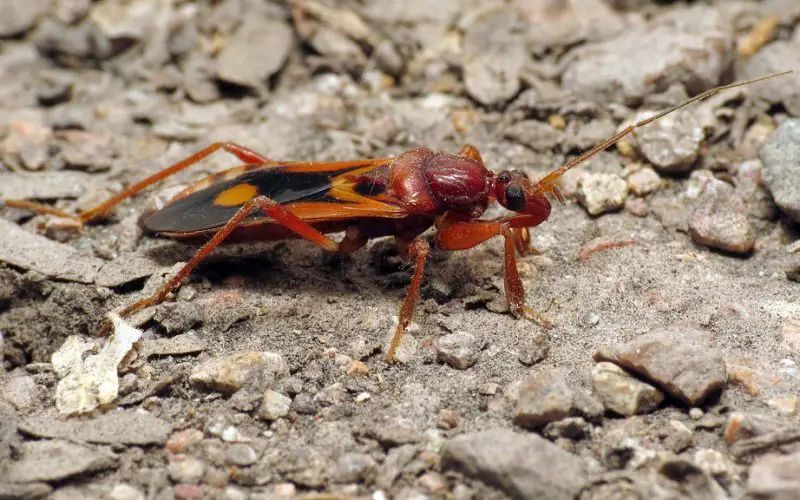
In the Northwest, black and orange Western Corsair Bugs (Rasahus thoracicus) are common and grow to a hefty 23mm in size. These bugs are distinguished by their eye-catching black dorsum that features a huge circular orange spot and a chevron-shaped patch next to the head. They also have partial orange edges, orange heads, and orange legs. As predators, they eat a variety of tiny insects as well as other insects’ eggs and larvae. Despite not carrying any dangerous diseases or viruses, Western Corsair bugs are notorious for their aggression and can cause excruciating bites.
Neocapsus Cuneatus
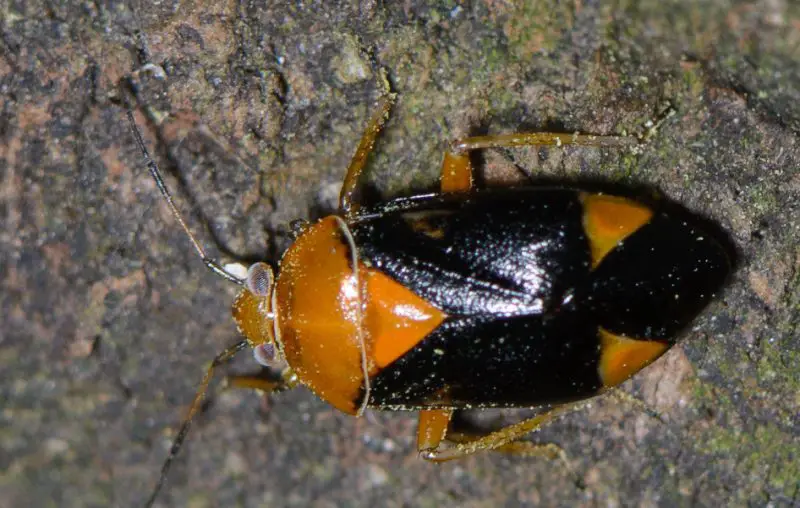
Though it doesn’t infiltrate homes, Neocapsus cuneatus is a black and partially orange bug that resembles an American cockroach in shape. It grows up to 10–12 mm, feeding mostly on grasses, leaves, and plant stems. It can be recognized by its three pairs of legs and black body, as well as an orange band located directly behind its head. As the beetle ages, more orange hues on the dorsum become darker. This bug, which is not considered a pest, benefits the ecology without endangering homes.
Rhynocoris Ventralis
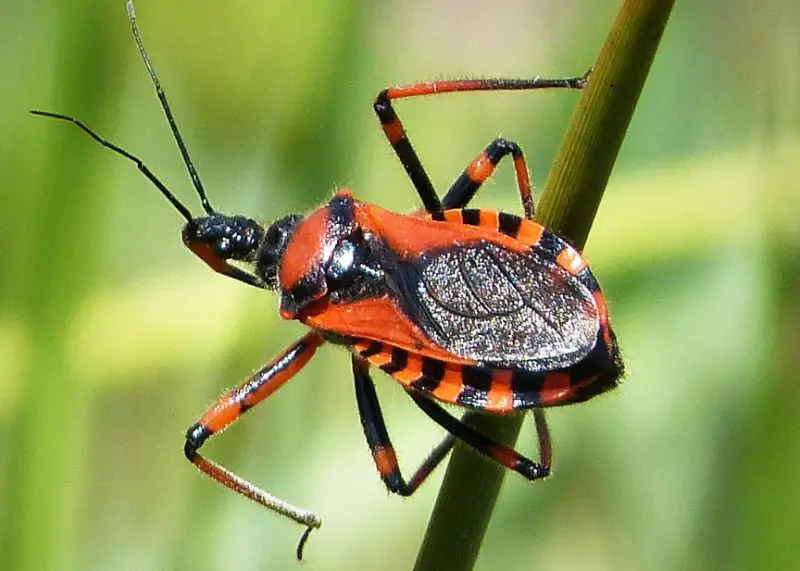
Rhynocoris ventralis is an orange-and-black terrestrial assassin beetle that uses ambush techniques to prey on small insects and larvae, with the ability to bite. Its head and dorsal center are mostly black, while its legs and body are half orange. Orange or orange-brown tones might be seen on the borders and lower abdomen. The beetle has bright orange borders punctuated by two black bands, and its legs are decorated in small black dots. It prefers a terrestrial environment and hides under leaves or other vegetation to elude its victim.
Oncometopia Hamiltoni

The Oncometopia hamiltoni is a native of Mexico and Southern Texas. It feeds on the leaves of plants. It is easily distinguished from green vegetation by its tricolored body. The dorsum is mostly black with bright blue patches stretching from the head to the tip of the belly. It has a wide head and an orange ventral hue. This beetle, which is 11.4 mm in size, demonstrates exceptional jumping ability by jumping from one leaf to another. It feeds via puncturing mouthparts that are used to draw plant juice from leaves.
Southern Small Milkweed Bug

Similar to the Six-spotted Milkweed bug, the Southern Small Milkweed bug (Lygaeus reclivatus) shows a distinct nutritional change. It starts off eating the seeds of milkweed and sucking the nectar, but when that food source is scarce, it quickly switches to eating insects. The bug, which is 12 mm in size, resembles some of the biggest black and orange bugs that are frequently found in North America. It has a black body with wide orange stripes.
Blood-Colored Milkweed Bug
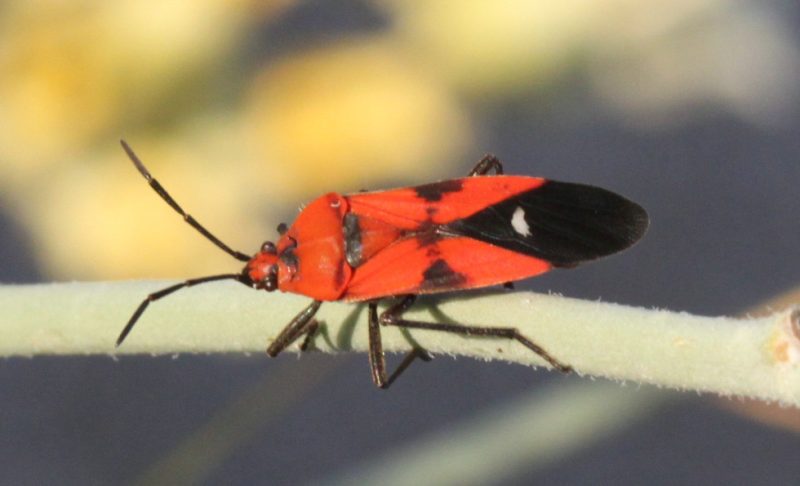
The name Blood-colored Milkweed bug (Oncopeltus sanguineolentus) comes from the vivid orange-red color that both adults and nymphs of the species exhibit. This species is native to North America and is most prevalent in the desert regions of the southern states. Its main food source, Desert Milkweed, helps it to flourish. The dorsal section of the bug is a striking blood-orange color, with a few noticeable black markings, including a larger spot on the apex of the abdomen. This beetle, which is complemented by black legs, is common in areas like Arizona, California, and Nevada that have an abundance of milkweed.
People Who Read This Also Read:

